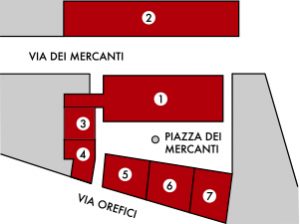
e antiche vie d’accesso alla città tracciate su di una pianta del XVII (Laferri)
Le più antiche tracce di insediamento nell’area di Piazza

dei Mercanti risalgono al V secolo a.C.: i lavori urbanistici tra la fine dell‘800 e l’inizio del ‘900 ne evidenziarono i primi resti. Recentissimi scavi hanno permesso di valutarne l’estensione per nuclei, disposti su circa 12 ettari, in un’area compresa tra piazza Cordusio, via Meravigli, via Moneta, la Biblioteca Ambrosiana e piazza Duomo. Fra le antiche tradizioni sulla fondazione di Milano, oggi la più attendibile è quella che la lega ai Celti che in quest’area trovarono un punto di aggregazione religiosa, prima ancora che un insediamento abitativo. Questa forse anche la spiegazione del nome Mediolanum, punto centrale e d’incontro. Lo stesso storico greco Polibio, nel II sec. a.C., riportava l’origine celtica di Milano che Tito Livio, nelle sue Storie, circa due secoli più tardi, avrebbe confermato, indicando nel nipote del re dei Biturgi, Belloveso, il fondatore. Accanto alle notizie sulla fondazione e ai miti che poggiano su leggende tramandate nei secoli, appare il simbolo della “scrofa semilanuta”. È il poeta Claudiano – nel IV secolo d.C. – il primo che in un poemetto nuziale immagina Venere che vola sulle mura fondate dai Galli sulle quali sono esposte pelli di scrofa lanuta. Di qui in avanti il richiamo alla scrofa come emblema di Milano sarà tramandato nei secoli e spesso raffigurato, pur non avendo una chiara genesi. Nella piazza troviamo la scrofa semilanuta rappresentata su più palazzi. La raffigurazione più antica è su un resto rinvenuto durante i lavori di costruzione del Palazzo della Ragione (1233) dove oggi lo ritroviamo incastonato su uno dei pilastri degli archi.
The first traces of a settlement in the area of the Piazza dei Mercanti  date back to the fifth century BC: the urban renewal schemes in the late nineteenth and early twentieth centuries brought the oldest remains to light. More recent excavations have revealed that it comprised a number of nuclei located on a site of about 12 hectares between Piazza Cordusio, Via Meravigli, Via Moneta, the Biblioteca Ambrosiana and Piazza Duomo. Of the ancient traditions relating to the foundation of Milan, the most credible is the one linking it to the Celts, who found this to be an area of religious interest even before deciding to settle here. This may also explain the name ‘Mediolanum’, a central meeting point. In the second century BC the Greek historian Polybius referred to the Celtic origin of Milan, which, around two centuries later, Livy confirmed in his history of Rome, suggesting that the founder was Bellovesus, the nephew of the king of the Bituriges. Together with the information about the city’s foundation and the myths based on legends handed down over the centuries, the symbol of the scrofa semilanuta (half-woolly sow) appears. It was in the forth century BC that the poet Claudian, in a wedding poem, imagined Venus flying over the walls built by the Gauls upon which skins of woolly sows were spread. From then onwards, references to the sow as the emblem of Milan were frequent and it was often portrayed, although it did not have a clear origin. The half-woolly sow is depicted on a number of buildings in the piazza: the oldest representation is in a bas-relief found in 1233 when the Palazzo della Ragione was being constructed and now set into one of the pillars of its arches.
date back to the fifth century BC: the urban renewal schemes in the late nineteenth and early twentieth centuries brought the oldest remains to light. More recent excavations have revealed that it comprised a number of nuclei located on a site of about 12 hectares between Piazza Cordusio, Via Meravigli, Via Moneta, the Biblioteca Ambrosiana and Piazza Duomo. Of the ancient traditions relating to the foundation of Milan, the most credible is the one linking it to the Celts, who found this to be an area of religious interest even before deciding to settle here. This may also explain the name ‘Mediolanum’, a central meeting point. In the second century BC the Greek historian Polybius referred to the Celtic origin of Milan, which, around two centuries later, Livy confirmed in his history of Rome, suggesting that the founder was Bellovesus, the nephew of the king of the Bituriges. Together with the information about the city’s foundation and the myths based on legends handed down over the centuries, the symbol of the scrofa semilanuta (half-woolly sow) appears. It was in the forth century BC that the poet Claudian, in a wedding poem, imagined Venus flying over the walls built by the Gauls upon which skins of woolly sows were spread. From then onwards, references to the sow as the emblem of Milan were frequent and it was often portrayed, although it did not have a clear origin. The half-woolly sow is depicted on a number of buildings in the piazza: the oldest representation is in a bas-relief found in 1233 when the Palazzo della Ragione was being constructed and now set into one of the pillars of its arches.